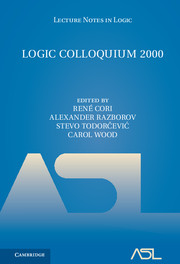Book contents
- Frontmatter
- Introduction
- Contents
- K. Jon Barwise (1942-2000)
- TUTORIALS
- PHOTOGRAPHS
- ARTICLES
- Bounded forcing axioms and the size of the continuum
- Hilbert's wide program
- Rigidity conjectures
- Metapredicative and explicit Mahlo: a proof-theoretic perspective
- A two-dimensional tree ideal
- Psychology looks hopefully to logic
- Russell's logics
- Partitioning pairs of uncountable sets
- Aspects of the Turing jump
- Liouville functions
- References
A two-dimensional tree ideal
from ARTICLES
Published online by Cambridge University Press: 27 June 2017
- Frontmatter
- Introduction
- Contents
- K. Jon Barwise (1942-2000)
- TUTORIALS
- PHOTOGRAPHS
- ARTICLES
- Bounded forcing axioms and the size of the continuum
- Hilbert's wide program
- Rigidity conjectures
- Metapredicative and explicit Mahlo: a proof-theoretic perspective
- A two-dimensional tree ideal
- Psychology looks hopefully to logic
- Russell's logics
- Partitioning pairs of uncountable sets
- Aspects of the Turing jump
- Liouville functions
- References
Summary
Introduction. Each of the classical tree forcings, such as Sacks forcing S, Laver Forcing L or Miller forcing M, is associated with a ideal on (in the case of S) or on (in the case of L or M). These can be considered forcing ideals in the sense that a real (in or) is generic for the respective forcing iff it avoids all the sets from the associated ideal defined in the ground model. Such ideals were first studied by Marczewski [9], later by Veličković [16], and Judah, Miller, Shelah [5]. They all studied the Sacks ideal. The ideals associated with Laver or Miller forcing were investigated by Brendle, Goldstern, Johnson, Repický, Shelah and Spinas (see [3], [4], [12] and [2] (chronological order)). In all these papers, among other things the additivity and covering coefficients were studied. Let J(Q) denote the ideal associated with the forcing Q. The typical problem was whether for in the trivial chain of inequalities
any of the inequalities could consistently be strict. Here add(J), cov(J) denotes the additivity, covering coefficient of the ideal J, respectively. One of the main results of [5] is that, letting and a countable support iteration of S of length, then is a model for add(J(S)) < cov(J(S)). The hard part of the argument is to show that is a model for. Building on these arguments, analogues of this result were proved in [4] for J(M) and J(L): For, letting denote a countable support iteration of length of Q and V is a model for. Actually, for Q = M this result needs a lemma from [12] which was not yet available in [4]. Again, the hard part was to show that holds in the extension. For this, it was proved that the cardinal invariant h which is defined as the distributivity number of is an upper bound of add(J(Q)) in.
- Type
- Chapter
- Information
- Logic Colloquium 2000 , pp. 294 - 322Publisher: Cambridge University PressPrint publication year: 2005
References
- 1
- Cited by

